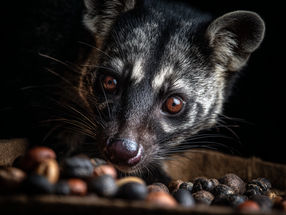The spider with the bee venom - New perspectives for the search for active substances against cell-based diseases
Researchers decode the toxin arsenal of the most poisonous native spider species
Advertisement
The nurse spider is the most poisonous spider in Germany. Its bite can lead to symptoms that require medical treatment. Despite this, the venom cocktail of this spider was virtually unknown until now. Researchers at Justus Liebig University Giessen (JLU) and the Fraunhofer Institute for Molecular Biology and Applied Ecology (IME) have now been able to decode the venom of the Nurse Thornfinger for the first time, gaining important insights into the evolution and pharmacology of its toxins. The work has been published in the journal "Communications Biology".
Spiders are venomous animals and feared by many people. However, the bites of most species, especially in Germany, are completely harmless to humans and often even asymptomatic. An exception to this is the nurse spider (Cheiracanthium punctorium), whose bite causes symptoms that are extremely unusual for spiders: severe pain, swelling and sometimes even circulatory problems, which can lead to medical emergencies in children and people with previous illnesses. Researchers from JLU and IME have now decoded the potent venom of this spider using modern systems biology methods.
"We have identified a whole catalog of new, exciting toxins and were able to show how the nurse spider can cause such painful poisoning," says Dr. Tim Lüddecke, head of the "Animal Venomics" working group at JLU's Institute of Insect Biotechnology and first author of the study. The venom of the nurse thorn finger contains many components that attack cell structures - similar to bee venom - and thus cause the strong local effects. "A type of toxin called CPTX and the enzyme phospholipase A2 are primarily responsible for this," says Lüddecke.
Through extensive comparative analyses of toxins from the entire spider kingdom and by means of evolutionary reconstructions, the researchers were able to deduce that both toxins have undergone a complex evolutionary history. While the toxin family of CPTX and its relatives emerged early in the evolution of modern spiders and acquired their characteristic structure through gene fusion, significant amounts of phospholipase A2 are only found in the nurse spider finger.
Defensive venoms are characterized by a rapid onset of severe pain, which enables rapid defence against enemies. Phospholipase A2 is found in many animals that use their venom defensively, especially insects. The researchers studied its structure and found that the phospholipases in the nurse thorn finger are similar to those in bee venom. They suspect that the pharmacological and structural similarity between the venom of the nurse thorn finger and bee venom is due to their comparable biological function. "In contrast to other spiders, the nurse spider uses its venom primarily to defend its brood," explains Lüddecke. "Bees and some other species also have classic defensive venoms. Apparently, evolution reacts with similar biomolecular solutions to comparable problems, although the respective species are not closely related."
This opens up new perspectives for the search for active substances. For example, spider venom has so far been considered almost exclusively in the search for new lead structures for the treatment of neuronal diseases. "However, the range of toxins in nurse spider venom that attack cells indicates that they should also be evaluated for active substances against cell-based diseases such as cancer in the future," says Lüddecke.
Note: This article has been translated using a computer system without human intervention. LUMITOS offers these automatic translations to present a wider range of current news. Since this article has been translated with automatic translation, it is possible that it contains errors in vocabulary, syntax or grammar. The original article in German can be found here.


























































